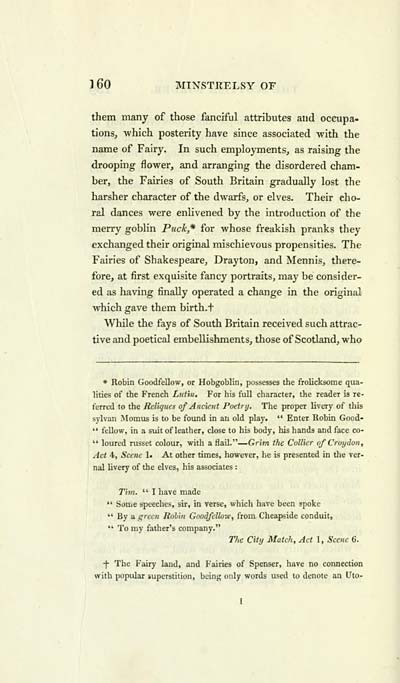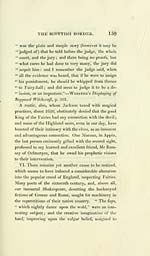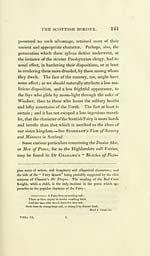Download files
Complete book:
Individual page:
Thumbnail gallery: Grid view | List view

160 :\ITXST11ELSY OF
them many of those fanciful attributes and occupa-
tions, which posterity have since associated with the
name of Fairy. In such employments, as raising the
drooping flower, and arranging the disordered cham-
ber, the Fairies of South Britain gradually lost the
harsher character of the dwarfs, or elves. Their cho-
ral dances were enlivened by the introduction of the
merry goblin Puck* for whose freakish pranks they
exchanged their original mischievous propensities. The
Fairies of Shakespeare, Drayton, and Mennis, there-
fore, at first exquisite fancy portraits, may be consider-
ed as having finally operated a change in the original
which gave them birth.t
While the fays of South Britain received such attrac-
tive and poetical embellishments, those of Scotland, who
♦ Robin Goodfellow, or Hobgoblin, possesses the frolicksome qua-
lities of the French Liitin. For his full character, the reader is re-
ferred to the Reliqucs of Ancient Poetry. The proper livery of this
sylvan Momus is to be found in an old play. " Enter Robin Good-
" fellow, in a suit of leather, close to his body, his hands and face co-
" loured russet colour, with a flail." — Grim the Collier of Croydon,
Act 4, Scene 1. At other times, however, he is presented in the ver-
nal livery of the elves, his associates :
T'nn. " I have made
" Some speeches, sir, in verse, which have been spoke
" By a green Rolin Goodfellow, from Cheapside conduit,
" To my father's company."
The City Match, Act 1, Scene 6.
f The Fairy land, and Fairies of Spenser, have no connection
with popular superstition, being only words used to denote an Uto-
them many of those fanciful attributes and occupa-
tions, which posterity have since associated with the
name of Fairy. In such employments, as raising the
drooping flower, and arranging the disordered cham-
ber, the Fairies of South Britain gradually lost the
harsher character of the dwarfs, or elves. Their cho-
ral dances were enlivened by the introduction of the
merry goblin Puck* for whose freakish pranks they
exchanged their original mischievous propensities. The
Fairies of Shakespeare, Drayton, and Mennis, there-
fore, at first exquisite fancy portraits, may be consider-
ed as having finally operated a change in the original
which gave them birth.t
While the fays of South Britain received such attrac-
tive and poetical embellishments, those of Scotland, who
♦ Robin Goodfellow, or Hobgoblin, possesses the frolicksome qua-
lities of the French Liitin. For his full character, the reader is re-
ferred to the Reliqucs of Ancient Poetry. The proper livery of this
sylvan Momus is to be found in an old play. " Enter Robin Good-
" fellow, in a suit of leather, close to his body, his hands and face co-
" loured russet colour, with a flail." — Grim the Collier of Croydon,
Act 4, Scene 1. At other times, however, he is presented in the ver-
nal livery of the elves, his associates :
T'nn. " I have made
" Some speeches, sir, in verse, which have been spoke
" By a green Rolin Goodfellow, from Cheapside conduit,
" To my father's company."
The City Match, Act 1, Scene 6.
f The Fairy land, and Fairies of Spenser, have no connection
with popular superstition, being only words used to denote an Uto-
Set display mode to: Large image | Transcription
Images and transcriptions on this page, including medium image downloads, may be used under the Creative Commons Attribution 4.0 International Licence unless otherwise stated. ![]()
| Early Gaelic Book Collections > J. F. Campbell Collection > Minstrelsy of the Scottish border > Volume 2 > (172) |
|---|
| Permanent URL | https://digital.nls.uk/80616755 |
|---|
| Description | Vol. II . |
|---|---|
| Shelfmark | Cam.2.d.18 |
| Attribution and copyright: |
|
| Description | Volumes from a collection of 610 books rich in Highland folklore, Ossianic literature and other Celtic subjects. Many of the books annotated by John Francis Campbell of Islay, who assembled the collection. |
|---|
| Description | Selected items from five 'Special and Named Printed Collections'. Includes books in Gaelic and other Celtic languages, works about the Gaels, their languages, literature, culture and history. |
|---|

